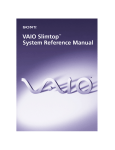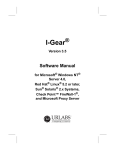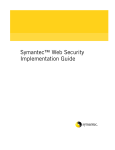Download VAIO Slimtop LCD Computer User Guide
Transcript
™ VAIO Slimtop Computer/ VAIO Slimtop LCD Computer User Guide PCV-L400/PCV-L600/PCV-L600S ® i © 1999 Sony Electronics Inc. Reproduction in whole or in part without written permission is prohibited. All rights reserved. This manual and the software described herein, in whole or in part, may not be reproduced, translated, or reduced to any machine-readable form without prior written approval. Sony, VAIO, the VAIO logo, VAIO Slimtop, Ergo-Angle, AutoAlert, VAIO Smart, Memory Stick, Digital Media Park, Mavica, and PictureGear are trademarks of Sony. Windows and the Windows logo are registered trademarks of Microsoft Corporation. K56flex is a trademark of Lucent Technologies Inc. and Rockwell International. All other trademarks are trademarks of their respective owners. Declaration of Conformity Trade Name: SONY Model No.: PCV-L400/PCV-L600/PCV-L600S Responsible Party: Sony Electronics Inc. Address: 1 Sony Drive Park Ridge, NJ 07656 Telephone No: 201-930-6970 This device complies with Part 15 of FCC Rules. Operation is subject to the two following conditions: (1) This device may not cause harmful interference, and (2) this device must accept any interference received, including interference that may cause undesired operation. Owner’s Record The model number and serial number are located on the back of your Sony computer. Record the model and serial numbers in the space provided here. Refer to the model and serial number when you call your Sony Service Center. Model Number: _____________ Serial Number:______________ Contents Features ............................................................................................. 4 Unpacking Your Computer............................................................ 6 Locating Controls and Connectors................................................ 8 Attaching the Stand to the System Unit ..................................... 14 Registering Windows® 98 ............................................................ 15 Registering Your Computer ......................................................... 16 Using the Programmable Power Keys (PPK) ............................ 17 Using Memory Stick Media.......................................................... 23 Using PC Cards .............................................................................. 25 Using the Standby Function ......................................................... 27 Shutting Down Your Computer .................................................. 28 Using the System Recovery CD(s)............................................... 30 Using the Application Recovery CD(s) ...................................... 32 About the Software on Your Computer ..................................... 33 For Answers to Your Software Questions.................................. 37 Troubleshooting ............................................................................. 39 Specifications .................................................................................. 43 Index ................................................................................................ 46 3 4 Sony VAIO Slimtop LCD Computer User Guide Features ✍ For a complete description of the specifications of your Sony computer, see “Specifications” on page 43. ❑ Exceptional performance: Your computer includes a fast Intel® processor and a V.90 compatible data/fax modem.* ❑ Ergo-Angle™ Multimedia LCD display†: The exclusive dual-hinge pedestal provides twice the flexibility of other LCD displays. Select the perfect viewing angle and enjoy the built-in stereo speakers. ❑ AutoAlert™ E-mail Notification System†: Custom software automatically downloads e-mail on a pre-set schedule via Microsoft Outlook®. A light on the LCD display instantly lets you know when new mail is received. ❑ VAIO Smart™ convertible keyboard: The innovative palm rest converts to a keyboard cover for a sleek look when not in use. Six Programmable Power Keys let you launch any application with the push of a button; dual-sided mouse connections for left- or righthand use. ❑ Sony Memory Stick™ media slot: The next generation of digital media, smaller than a stick of gum. Easily deliver information from one electronic device to another, so you can transfer images, sounds, data and text between cameras, computers, and more. ❑ Compact components: Enjoy the small footprint and versatile set up options available by positioning the components in an arrangement of your choice. ❑ Sony audio and video quality: High-fidelity 3D audio system and high-powered 3D graphics (AGP) enable you to take advantage of today’s advanced multimedia applications, games, and entertainment software. * Actual upload and download speeds may vary due to line conditions, ISP support, and government regulations. † Available only with the VAIO Slimtop™ LCD Computer. Sony VAIO User’s Guide Features 5 ❑ 100 free hours of Internet access: Use the Internet for up to 100 free hours when you sign up with GTE (no credit card required). Free access expires 100 hours or 60 days after signing up—whichever occurs first. ❑ Preinstalled software titles: All the software on your computer is preinstalled, configured, and ready for you to use right out of the box. ❑ Windows® 98: Your system includes the latest operating system from Microsoft. ❑ Communications: Access popular online services, browse the Internet, send faxes, and more. 6 Sony VAIO Slimtop LCD Computer User Guide Unpacking Your Computer Computer and Supplied Accessories System unit LCD (VAIO Slimtop LCD models only) Keyboard Mouse Spacers Stand (for vertical installation; screw is attached) Keyboard cable Ferrite core Phone cable Power cable Unpacking Your Computer 7 Manuals ❑ Read Me First contains last-minute supplementary information and software support numbers. ❑ The VAIO Slimtop Computer/VAIO Slimtop LCD Computer User Guide (this manual) contains features and specifications of your computer. It also includes information on the applications included with your system and how to contact software vendors, get started with your computer, and solve common problems. ❑ The VAIO Consumer Information Guide contains safety and regulatory information, ergonomic considerations, information on help resources, and your computer’s limited warranty statement. ❑ The Microsoft® Windows®98 Getting Started manual explains how to use the basic features of the Windows operating system. Recovery CDs ❑ System Recovery CD(s) ❑ Application Recovery CD(s) Other ❑ Setting up your VAIO Slimtop LCD Computer (poster) or Setting up your VAIO Slimtop Computer (poster) ❑ Packet containing special product offers Software CDs ❑ Microsoft® Encarta® 99 Encyclopedia ❑ Microsoft® Money/Microsoft® Works 8 Sony VAIO Slimtop LCD Computer User Guide Locating Controls and Connectors Front Panel FD CD HD 1 Power switch and indicator light Turns on/off the computer and the display. The indicator light is green while the power is on. 2 Floppy disk drive Reads/writes data from/to the 3.5 inch floppy disk. 3 Floppy disk eject button Ejects the floppy disk. 4 CD-ROM drive Reads data from the CD-ROM. 5 CD-ROM eject button Ejects the CD-ROM. 6 Manual eject hole If the CD-ROM does not come out when you press the CD-ROM eject button, insert a thin, pointed object into this hole to eject the CD-ROM manually. Locating Controls and Connectors FD CD 9 HD 7 FD (Floppy disk drive) access indicator light Lights in green while reading/writing data from/to the floppy disk. 8 CD (CD-ROM drive) access indicator light Lights in amber while reading data from the CD-ROM. 9 HD (Hard disk drive) access indicator light Lights in green while reading/writing data from/to the hard disk. 0 MIC (Microphone) connector* Connects a microphone (not supplied). qa PHONES (Headphones) connector* Connects headphones (not supplied). qs VOLUME control Adjusts the volume of the headphones connected to the PHONES connector. VAIO Slimtop LCD Computer users should note that this does not control the volume of the integrated LCD speakers. qd PC CARD slot (with Zoomed Video support) A PC Card (also called a PCMCIA card) can be installed in this slot. PC cards enable you to add functionality to your system. qf MEMORY STICK media slot Insert a Sony Memory Stick™ card into this slot. See “Using Memory Stick Media” on page 23 for details on using Memory Stick media. qg USB (Universal Serial Bus) connector Connects a USB device. * See “Using a Headphone or Microphone” on page 11 for important information about connecting a microphone and headphone. 10 Sony VAIO Slimtop LCD Computer User Guide Rear Panel LINE PRINTER PRINTER SERIAL SERIAL MONITOR USB MONITOR IN LINE OUT USB IN PHONE LCD LINE OUT KEYBOARD LCD 1 AC INPUT connector Connects the supplied power cord. 2 LINE jack Connects a phone cable to the wall jack. 3 TELEPHONE jack Connects the phone to the computer. 4 PRINTER connector Connects a parallel device such as a printer or scanner. 5 SERIAL connector Connects a serial device such as a digital still camera. 6 MONITOR connector Connects a standard CRT display. 7 USB (Universal Serial Bus) connector Connects a USB device. 8 LINE IN connector Connects an audio device. 9 LINE OUT connector Connects an audio device or an active speaker. KEYBOARD Locating Controls and Connectors 11 0 LCD MONITOR connector (VAIO Slimtop LCD models only) Connects the LCD that comes with the VAIO Slimtop LCD Computer. Note: Do not connect any display to this connector other than the LCD that is supplied with this system. qa KEYBOARD connector Connects a keyboard. Using a Headphone or Microphone When you connect a microphone or headphone to your computer, attach the supplied ferrite core at the end of the headphone or microphone cable closest to the computer. Wrap the cable through the center of the ferrite core. The following illustration shows how to attach the ferrite core when you are using both a headphone and microphone. Microphone and headphone cables Ferrite core Plugs connected to the computer ✍ The LCD and keyboard cables already include a ferrite core. Do not remove the ferrite core from these cables. (LCD cable available with VAIO Slimtop LCD models only.) 12 Sony VAIO Slimtop LCD Computer User Guide LCD (VAIO Slimtop LCD models only) 1 Power indicator light Light is green while the power is on. When the computer enters the standby mode, this indicator light is amber. 2 Information LED Light turns red to alert the user to activities, such as the arrival of e-mail. See “Using the AutoAlert E-mail Notification System (VAIO Slimtop LCD models only)” on page 20. 3 Brightness control Adjusts the brightness of the screen. 4 Volume control Adjusts the volume of the integrated speakers on the LCD display. Locating Controls and Connectors 13 To adjust the height and viewing angle of the display (VAIO Slimtop LCD models only) Holding both sides of the display, push the display panel out and up, and then adjust the viewing angle. ✍ The LCD display is designed to maintain the best ergonomic viewing angle. Set the display height so that it does not touch the keyboard, and adjust the viewing angle approximately 27 degrees from eye level to the center of the screen. 14 Sony VAIO Slimtop LCD Computer User Guide Attaching the Stand to the System Unit The main system unit can be oriented horizontally or vertically. If you place the system in a vertical position, you must attach the supplied stand to ensure stability. 1 Place the system unit on its right side, with the front of the system facing forward. 2 Insert the grooved side of the stand into the ventilation holes of the system so that the two screw holes are aligned and the stand’s fins are at the rear of the unit. 3 Secure the stand to the unit with the supplied screw. Registering Windows® 98 15 Registering Windows® 98 The first time you turn on your computer, you need to complete a few steps to register and configure the Windows 98 software that is already installed on your computer. You do not need to repeat these steps each time you turn on your computer. ✍ You must complete the process described below before you can use your computer. The on-screen instructions guide you through the registration and configuration process. The following is an overview of the process. 1 Gathering information: ❑ Enter your name. ❑ Read and accept the License Agreement. ❑ Enter your Certificate of Authenticity number located on the cover of the Microsoft Windows 98 Getting Started manual. 2 Windows 98 setup: Click the Finish button on the Windows 98 Setup Wizard screen. 3 Selecting your computer settings: If necessary, change the Time Zone, Date, and Time on the Date/Time Properties screen. 4 Registering your computer: For details on registering your computer, see “Registering Your Computer” on page 16. You can also sign up for 100 free hours of Internet service at this time. 5 Learning about Windows: If you want, take the tour of Windows. 16 Sony VAIO Slimtop LCD Computer User Guide Registering Your Computer Take advantage of Sony’s commitment to quality customer support and receive these benefits by registering your computer: ❑ Sony Customer Support—Talk to a Support Representative to troubleshoot problems you may be having with your computer. ❑ Limited warranty—Protect your investment. See “Limited Warranty Statement” in the VAIO Consumer Information Guide for details. ✍ You must register your computer to extend the warranty from the initial 90-day warranty period to one year from the original date of purchase. ❑ Express Service—Provides convenient resolution of problems. ❑ Free Internet access—Use the Internet for up to 100 free hours when you sign up with GTE (no credit card necessary). Free access expires after 100 hours of use or 60 days after signing up, whichever occurs first. If you have not already registered, follow these steps to use the computer online registration service. 1 2 Click the Sony VAIO Registration icon on the VAIO desktop. 3 4 Click the Next button to advance to the next form. Enter the information requested on the first online registration form. Press the TAB key to move from box to box. Complete the remaining forms by clicking the Next button each time you complete a form. The computer automatically transfers your registration information using your built-in modem and a toll-free telephone number. If you do not sign up for your free Internet account at the time of registration, you can use the Easy Internet Access icon on the Windows desktop to sign up later. Using the Programmable Power Keys (PPK) 17 Using the Programmable Power Keys (PPK) Your Sony computer comes with technology that allows you to get to your favorite applications easily. Each Programmable Power Key (PPK) on your VAIO Smart Convertible Keyboard comes programmed to launch a preset application with a single press of the key. If you wish, you can use the PPK Setup software to change the Programmable Power Keys’ preset functions. The PPK Setup software also allows you to set your computer’s internal timer to launch certain applications automatically. The Programmable Power Keys are located at the top of your keyboard, and are numbered P1 through P6. The keys work even when the computer is turned off. Pressing one turns on the computer and launches the preset application. The six Programmable Power Keys come to you preprogrammed to perform the functions listed in the table below. Key Function P1 (INTERNET) Starts Microsoft® Internet Explorer for Windows®. P2 (MAIL) Starts Microsoft® Outlook® 98. P3 (WORK) Starts Microsoft® Works. P4 (FINANCE) Starts Intuit® Quicken® 99. P5 (SETUP) Starts PPK Setup. P6 (HELP) Opens a menu of help options. 18 Sony VAIO Slimtop LCD Computer User Guide Changing the Functions of the Programmable Power Keys To change the function of a Programmable Power Key: 1 Press the P5 button on the keyboard, or double-click the PPK Setup icon on the taskbar. The PPK Setup screen appears. 2 Click the Programmable Power Key tab (“PPK1,2,3” or “PPK4,5,6”) for the Programmable Power Key you want to change. 3 Click the icon showing the key whose function you want to change. The Assignment screen appears. 4 Select “Change the assigned application” and click Next. The How to Choose an Application screen appears. 5 Click “Select application from Registered Files list” and then click Next. The Assign Function screen appears. ✍ Other options on the How to Choose an Application screen include “Register new application,” “Select Predefined Functions,” and “Create a new Preset Script.” You can press the Help button to learn more about these options. 6 Select (highlight) an application in the Registered Files column and then click Finish. 7 The PPK tab appears. Click Apply. The application you have just selected is now assigned to the Programmable Power Key you chose in step 3. 8 Click OK to exit PPK Setup. Using the Programmable Power Keys (PPK) 19 Using the Internal Timer You can use PPK Setup’s internal timer to start an application at a specific time. The timer can start applications even when the power is off. 1 Press the P5 button on the keyboard, or double-click the PPK Setup icon on the taskbar. The PPK Setup screen appears. 2 3 4 Click the Timer tab. Click the clock icon. If an application is already assigned to the timer, the Assignment screen appears. Choose “Change the assigned application” and then click Next. If no application is currently assigned to the timer, the Assignment screen does not appear; proceed to step 5. 5 The How to Choose an Application screen appears. Choose “Select application from Registered Files list” and then click Next. 6 The Assign Function screen appears. Select an application in the Registered Files column and then click Finish. 7 8 The Timer tab appears. Click Apply, then click the Set button. The Timer Schedule Setting screen appears. ❑ Select “One time only” if you want the application to launch only once. ❑ Select “Weekly” if you want the application to start at a certain time on a regular basis, such as weekly or on certain days of the week. Then click Next. 9 Specify the day and time for the timer to start. Note that the time is in 24 hour format. If you selected “Weekly” in the previous step, you have the option of specifying more than one day. Then click Next. 20 Sony VAIO Slimtop LCD Computer User Guide 10 The Post Processing screen appears. Entering information on this screen is optional. If you wish, you can set the computer to shut down or enter system standby mode after the timer finishes launching an application. Click the Help button for instructions. When you have finished, or if you do not wish to choose any options on the Post Processing screen, click Finish. 11 The Timer tab appears. Click Apply. The timer is now set to launch the application you selected in step 5. 12 Click OK to exit PPK Setup. ✍ Some software applications take longer than others to launch. It is advisable to confirm in advance the amount of time your selected application takes to start. Using the AutoAlert E-mail Notification System (VAIO Slimtop LCD models only) Your VAIO Slimtop LCD Computer can be set up to notify you with an Information LED when new mail arrives in your e-mail mailbox. The Information LED turns red to indicate that new e-mail has arrived. For this AutoAlert E-mail Notification System to work, you must use Microsoft® Outlook® 98 as your default e-mail software, and you must have an Internet Service Provider with dial-up capabilities set up. As an alternative, you can program PPK Setup to set the Information LED to turn on when PPK Setup has successfully completed the task of dialing up and connecting to receive mail; this works with Netscape Communicator® 4.5, Microsoft® Outlook® Express, and Microsoft Outlook 98. See “LCD (VAIO Slimtop LCD models only)” on page 12 for an illustration showing the Information LED’s location. Using the Programmable Power Keys (PPK) 21 To use the AutoAlert E-mail Notification System (VAIO Slimtop LCD models only) 1 Press the P5 button on the keyboard, or double-click the PPK Setup icon on the taskbar. The PPK Setup screen appears. 2 3 Click the Registration tab. 4 Under “What do you want to do?” select “Get Message” and choose Outlook 98 Mail Downloading from the drop-down list box. Then click Next. 5 The Information LED screen appears. Select “Turn on the Information LED when new e-mail message has arrived,” then select “MAPI,” and then click Next. Click the Preset Script button. The Preset Script Assignment screen appears. ✍ This only works if you are using Microsoft Outlook 98 as your default e-mail software. If you have chosen Netscape Communicator 4.5 or Microsoft Outlook Express instead, you can select “Turn on the Information LED when process is finished successfully.” This causes the Information LED to light when PPK Setup has launched your e-mail software and checked for mail, rather than after it actually downloads your e-mail. 6 The Enter Application Name screen appears. Enter an application name and description of your choice. For example, you might choose “MyE-mail” as the application name and “Download e-mail” as the description. Then click Finish. 7 Now you can use either a PPK button or the timer to download your e-mail. Follow the instructions under “Changing the Functions of the Programmable Power Keys” on page 18 or “Using the Internal Timer” on page 19. When you come to the Assign Function screen, select your newly named application from the Registered Files list. ✍ To turn off the Information LED, click the PPK icon in the Windows task tray. Some e-mail applications are programmed to ask for a password before downloading mail. If your e-mail software has this feature, PPK may not be able to download your mail successfully. You can solve this problem by setting your e-mail software to remember your password rather than prompting you for it. 22 Sony VAIO Slimtop LCD Computer User Guide PPK Setup Software Restrictions If you use software that uses a phone line ❑ The computer may not be able to disconnect the phone line due to communication and server conditions. ❑ Be sure to monitor the status of the software when running PPK Setup, and manually disconnect the phone line if you notice a malfunction. Furthermore, when using the timer to start the software, it is advised that you set the computer to shut down or enter system standby mode after a certain length of time. This allows the computer to disconnect the phone line if the computer fails to disconnect the line normally. If you are using the timer to download e-mail automatically It is advisable to set up your e-mail software to redial automatically if it does not connect the first time. It is also advisable to set the e-mail software to disconnect the phone line automatically when all mail has been downloaded. If you are using your 100 free hours of Internet access In order to use the AutoAlert E-mail Notification System with your free 100 hours of Internet access from GTE, the Dial automatically setting must be selected in your Microsoft® Outlook® 98 software. If you have not yet chosen this setting and wish to do so, start Outlook 98, click Send and Receive, and then check the Dial automatically check box in the dialog box that appears on the screen. (If the Dial automatically setting is already selected, this dialog box will not appear.) For information on your free GTE trial period, see page 5. Using Memory Stick Media 23 Using Memory Stick Media Your Sony computer is designed to support the new Memory Stick IC recording media. The Memory Stick card is a small, versatile device that allows you to share data between various types of Sony equipment. Your system comes with a sample 4 MB Memory Stick card for you to try. This Memory Stick card contains images saved from a Sony digital camera, which supports Memory Stick media. When you insert the supplied Memory Stick card, the PictureGear™ software's slide show application launches automatically and allows you to view the images. See the supplied Memory Stick card package for more information on Memory Stick card use, including information on how to create your own slide show. ✍ If using a Memory Stick card that does not contain Sony digital camera images, your computer automatically launches Windows Explorer. This allows you to view the contents of the Memory Stick card. Once you have created a slide show, you cannot rename the files in the slide show using the Windows Rename function. To change the name of a file in a slide show, follow the instructions on the Memory Stick card package. 24 Sony VAIO Slimtop LCD Computer User Guide To protect data on Memory Stick media from accidental changes The Memory Stick card contains a write-protect tab. The write-protect tab prevents accidental changes to a Memory Stick card. When you slide the write-protect tab to the LOCK position, the Memory Stick card is writeprotected, which means you cannot delete, copy, or save information on the Memory Stick card. When you slide the tab to the un-LOCK position, you can write to or modify the Memory Stick card contents. To unlock To lock LOCK LOCK LOCK To change the way the computer reacts when a Memory Stick card is inserted into the Memory Stick media slot Change the options on the Memory Stick tab in the PPK Setup software. Using PC Cards 25 Using PC Cards This computer has a card bus PC card slot that supports a Type I or II PC card. The slot also supports the ZV (Zoomed Video) port specification. To insert a PC card ✍ You do not need to shut down your computer when inserting a PC card. 1 Open the front panel. 2 Insert the PC card into the PC card slot until it clicks into position. ✍ When the card is completely inserted, the eject button pops out. If you cannot insert the card, do not forcibly insert it. In this case, make sure the card is not inserted upside-down or backward, and then reinsert the card into the slot carefully. See the manual that came with the PC card for details on using it. To close the front panel when the eject button is protruding, fold the button down onto the computer. 26 Sony VAIO Slimtop LCD Computer User Guide To eject a PC card ✍ If you eject the PC card incorrectly, the system may not work correctly. 1 Click the Start button on the Windows taskbar, click Settings, and then click Control Panel. 2 3 4 Click the PC Card icon. 5 Push the PC card eject button on the front panel of the system unit. You may need to pull out the eject button before you can eject the card. Click the name of the card that you want to eject, then click Stop. When the message “You may safely remove this device” appears, click OK. The card is ejected from the card connector. Remove the card by holding it by its edge and pulling it out carefully. Using the Standby Function 27 Using the Standby Function When you are finished using your computer, you can put it in standby mode rather than turn it off completely. Putting the computer in standby mode allows you to return quickly to normal computer use. To put the computer in standby mode manually 1 Save your work and close any applications that are running. (You can leave Microsoft Windows running.) 2 Press the (Standby) button on the top of the keyboard. The computer goes into standby mode. Alternatively, you can click the Start button on the Windows taskbar, click Shut Down, select Standby, and then click OK. To let the computer go into standby mode on a timer You can set the computer to go automatically into standby mode after there has been no activity on it for a specified time. You can set this length of time on the Windows Control Panel. 1 2 3 Click the Start button on the Windows taskbar. 4 Select a time from the “System standby” list box. Select Settings, and then click Control Panel. Click the Power Management icon, and then select the Power Schemes tab. The system will enter standby mode after there has been no activity on the computer for the amount of time you have specified. To resume from standby mode The best method is to press the (Standby) button again. ✍ If the display does not return from standby when you press the (Standby) button, your system may be in video standby mode. Press any key on the keyboard to return from video standby. 28 Sony VAIO Slimtop LCD Computer User Guide Standby Mode Indicators You can tell which mode the computer is in by the color of the power indicator light. Color Mode Amber Computer is in standby mode. Green Computer is out of standby mode, ready to use. No color Computer is turned off. ✍ In standby mode you may periodically hear the computer’s fan turn on and off, depending on the room’s temperature. This is normal functioning in standby mode. Shutting Down Your Computer When you are ready to turn off your computer for an extended period of time, use the following procedure to shut down the computer. ! To avoid the potential loss of data, do not use the power switch to shut down the computer. To shut down your computer ✍ If you plan to shut down your computer for a short period of time, you may want to use standby mode instead. See “Using the Standby Function” on page 27. 1 Click the Start button on the Windows taskbar to open the Start menu. 2 3 4 Click Shut Down to display the Shut Down Windows dialog box. Select the Shut Down option. Click OK to complete the shutdown process. ✍ Respond to any prompts about saving documents. 5 Wait for your computer to turn off automatically — the power indicator light turns off. 6 Turn off any peripherals connected to your computer. The LCD display (VAIO Slimtop LCD models only) turns off automatically when the computer shuts down. Shutting Down Your Computer 29 ✍ You can also shut down your computer using the (Power) button on the keyboard. Pressing this button causes the system to perform a shutdown but does not give you any of the other options available on the Windows 98 Shut Down menu. About the Power Switch If your system “locks up” or “crashes,” press and hold the power switch for four seconds to force your system to power off. You may need to repeat this procedure. See “Locating Controls and Connectors” on page 8 for the power switch’s location. 30 Sony VAIO Slimtop LCD Computer User Guide Using the System Recovery CD(s) You can reinstall software titles that shipped with your computer if they are corrupted or accidentally erased. You may not need to recover the entire contents of your hard drive. If you experience a problem with your computer, reinstalling an individual device driver or software title may correct the problem. Use the Application Recovery CD(s) to reinstall individual applications or device drivers. See “Using the Application Recovery CD(s)” on page 32. The System Recovery CD(s) contain a backup copy of all the software originally installed on your hard disk drive. They can be used only to recover the hard disk of the Sony computer you purchased. The System Recovery utility gives you three options: ❑ Full Restore without Format restores all the software titles that originally came with your computer without formatting the hard disk. ❑ Full Restore with Format formats the hard disk drive and then restores all the original software. ❑ Operating System Only formats the hard disk drive and restores the Windows operating system and the device drivers that shipped with your computer. This option is recommended for advanced users only. ! If you choose the Full Restore with Format or Operating System Only option, your hard disk will be formatted, which removes all the information on the hard disk drive. You will lose any software you have installed and any other files you have created since you started to use your computer. This means you will have to reinstall any applications that were not included with the computer when you purchased it. If you choose the Full Restore without Format option, you may need to reinstall applications that were not included with the computer when you purchased it. If you have any questions on using the System Recovery CD(s), contact Sony Customer Support. Using the System Recovery CD(s) 31 To use the System Recovery CD(s) ✍ You need to complete the Windows registration process when you use the System Recovery CD(s). Make sure you have the product ID number located on the cover of your Microsoft Windows manual. You will need this number to complete the recovery process. 1 Insert the Sony System Recovery CD in the CD-ROM drive. ✍ The System Recovery utility boots from the CD-ROM drive. It must be in the drive when you turn on the computer. 2 Shut down your computer as described in “Shutting Down Your Computer” on page 28. 3 4 Wait 30 seconds and turn on your computer. 5 When the System Recovery menu appears, follow the on-screen instructions to complete the recovery process. Click OK to signify you have read and accept the Microsoft End-User License Agreement. ✍ Your system may include one or two System Recovery CDs. If you have two System Recovery CDs, insert the first CD to run the System Recovery program. You are prompted to insert the second CD once the information from the first CD has been installed. The recovery process takes 30 to 60 minutes to complete. 32 Sony VAIO Slimtop LCD Computer User Guide Using the Application Recovery CD(s) The Application Recovery CD(s) allow you to reinstall individual applications and device drivers if they are corrupted or accidentally erased. Reinstalling an individual device driver or software title may correct a problem you are experiencing with your computer, and you may not need to recover the entire contents of your hard drive. If you do need to reinstall all the software titles that shipped with your computer, use the System Recovery CD(s). See “Using the System Recovery CD(s)” on page 30. You must be in Windows to run the Application Recovery CD(s). The application will not run from DOS. If you have any questions on using the Application Recovery CD(s), contact Sony Customer Support. To use the Application Recovery CD(s) 1 Turn on your computer. If your computer is already on, close all applications. 2 When the Windows desktop appears, insert the Sony Application Recovery CD in the CD-ROM drive. The Application Recovery utility loads automatically. 3 When the Application Recovery menu appears, follow the on-screen instructions to complete the recovery process. ✍ Your system may include one or two Application Recovery CDs. If you have two Application Recovery CDs, insert the first CD to run the Application Recovery program. You may be prompted to insert the second CD, depending on the application you wish to restore. About the Software on Your Computer 33 About the Software on Your Computer Your Sony computer is ready to help you work, play, learn, and communicate as soon as you turn it on. This section gives you an overview of the activities you can perform with your software titles. For support information, see “For Answers to Your Software Questions” on page 37. Adobe Acrobat® Reader Adobe Systems Inc. Acrobat Reader software allows you to view, navigate, and print electronic documents in Adobe Portable Document Format (PDF), an open file format that is intended to preserve the fidelity of documents created on all major computer platforms. Adobe PhotoDeluxe® Home Edition Adobe Systems Inc. Create amazing photo effects with Adobe PhotoDeluxe. Without learning complex software, you can enhance, restore, and be creative with your photos. Includes built-in guided activities, stock photos, clip art and templates to assist you. America Online® America Online America Online is the world's most popular Internet online service. Stay in touch with family and friends with Easy-to-Use E-mail, manage your personal finances, get the latest news and sports scores, and chat with thousands of others who share your interests. AT&T WorldNet® Service AT&T Fast, reliable Internet access from AT&T WorldNet Service. AT&T WorldNet Service provides web-based e-mail, a personalized start page from Excite, easy access to the Excite search engine, free web pages, online and live agent technical support, instant messaging, and special shopping discounts at Market Square. 34 Sony VAIO Slimtop LCD Computer User Guide CompuServe® CompuServe, Inc. CompuServe is the most comprehensive source of organized business and educational information online today. CompuServe allows you to access the vastness of the Internet, without wasting time wading through it. Maximize your time online with CompuServe. Digital Media Park™ Sony Electronics An integrated suite of multimedia cataloging and playback programs, including Media Bar, Media Library, and Media Showcase. Dr. Solomon's® Anti-Virus Dr. Solomon’s Software Inc. Dr. Solomon's Anti-Virus provides the most comprehensive defense against the spread of viruses, including macro viruses. It can scan inside compressed files and automatically protects your system against viruses sent via e-mail or Internet download. EarthLink Sprint TotalAccess™ EarthLink Network, Inc. An Internet Service Provider that supplies access, information, and assistance to its customers, introducing them to the Internet. Member benefits include e-mail, newsgroups, a Personal Start Page, a free 6 MB web site, a member magazine, and 24-hour technical support. Microsoft® Encarta® 99 Encyclopedia Microsoft Corporation Microsoft Encarta Encyclopedia combines current, comprehensive content with up-to-date multimedia technology providing users with unique, engaging learning experiences. With the 1999 edition, Encarta provides a wealth of information resources and unique interactive features. Microsoft® Internet Explorer for Windows® 98 Microsoft Corporation Internet Explorer delivers the web the way you want it. It is safe, easy to use, and you can personalize how you access the web. Outlook Express and other tools in Internet Explorer also help you have a great experience when you are on the web. About the Software on Your Computer 35 Microsoft® Money 99 Microsoft Corporation Microsoft Money 99 is personal finance software that lets you perform your financial tasks, everything from paying bills to planning for the future, in a smarter, faster way. With Money's online services, you can pay bills and bank from the comfort of home. Microsoft® Outlook® 98 Microsoft Corporation Outlook 98 is Microsoft's premier messaging and collaboration client. It combines the leading support for Internet standards-based messaging systems with integrated calendar, contact, and task-management features. Microsoft® Works Microsoft Corporation Works provides users with the right set of core tools that allows them to write letters and reports, track family and friends with the address book, manage home finances, and create a home inventory. Netscape Communicator® Netscape Communications Netscape Communicator is the all-in-one Internet tool that makes it easy to browse the web, send Internet e-mail, chat, read newsgroups, and compose great web documents. PictureGear™ Sony Electronics This image management software displays images from your hard drive, a Sony Digital Still Camera, or a Sony Mavica® Camera. The images appear in a convenient light-table format, so that you can easily view the contents of an entire folder. Prodigy Internet™ Prodigy Communications Corporation An Internet service that helps you find what you need online faster and smarter. Prodigy delivers powerful online content such as sports scores, stock quotes, news, and easy access to Excite™, plus a personal e-mail account and quality customer service, all at a competitive price. 36 Sony VAIO Slimtop LCD Computer User Guide Quicken® Basic 99 Intuit, Inc. Quicken is the fastest, easiest way to organize your finances. Quicken works just like your checkbook, so it is easy to learn and use. Quicken manages all of your finances, bank accounts, credit cards, investments, and loans. You can even pay your bills online. SurfMonkey™ MediaLive, Inc. SurfMonkey is a web browser and online service for kids ages 6-12 that makes the Internet safe, fun, and easy. A talking monkey guides children through web sites and chat rooms, and can read their e-mail out loud. Children cannot go to web sites identified by the browser as inappropriate, parents can screen e-mail messages, and chat sessions are monitored. WinFax® Basic Edition Symantec Corporation WinFax Basic Edition incorporates an easy-to-use interface that allows you to send and receive faxes easily. Upgrade to WinFax Pro to receive additional features. About Your Recovery CDs Application Recovery CD(s) Sony Electronics The Application Recovery CD program allows you to reinstall individual applications and device drivers. Use it to restore corrupted or accidentally erased files. System Recovery CD(s) Sony Electronics The System Recovery CD program allows you to restore the software titles that shipped with your computer if they become corrupted or are erased accidentally. It can be used only to restore the hard disk of the Sony computer you purchased. For Answers to Your Software Questions For Answers to Your Software Questions Acrobat® Reader, Adobe PhotoDeluxe® Business Edition (Adobe Systems Incorporated) http://www.adobe.com/ website phone 206-628-2746 (fee-based support) fax 206-628-5737 e-mail [email protected] hours M-F, 6 AM-5 PM PT America Online® (America Online) website http://www.aol.com/ phone 800-827-3338 hours 7 days a week, 6 AM - 2 PM ET AT&T WorldNet® Service (AT&T) website http://www.worldnet.att.net phone 800-400-1447 e-mail [email protected] hours 7 days a week, 24 hours a day CompuServe® Interactive (CompuServe Interactive, Inc.) http://www.compuserve.com/ website phone 800-848-8990 hours M-F, 8 AM - 1 AM ET, S-S 10 AM - 10 PM ET Dr. Solomon’s® Anti-Virus (Dr. Solomon’s Software Inc.) http://www.drsolomon.com/ website phone 888-377-6566 e-mail [email protected] hours 7 days a week, 24 hours a day EarthLink Sprint TotalAccess™ (EarthLink Network, Inc.) http://help.earthlink.net/techsupport/ website phone 800-395-8410 e-mail [email protected] hours 7 days a week, 24 hours a day 37 38 Sony VAIO Slimtop LCD Computer User Guide Easy Internet Access (Encompass, Inc.) http://www.encmpss.com/ website phone 800-927-3000 hours 7 days a week, 24 hours a day Windows 98 Operating System, Works, Money, Internet Explorer (Microsoft Corporation) http://www.microsoft.com/support/ website hours 7 days a week, 24 hours a day Netscape Communicator ® (Netscape Communications Corporation) http://www.netscape.com/ website hours 7 days a week, 24 hours a day Prodigy Internet™ (Prodigy Communications Corporation) http://www.prodigy.com/ website phone 800-PRODIGY hours 7 AM - 3 AM ET Quicken® Basic (Intuit Inc.) website http://www.intuit.com/support phone 900-555-4688 hours 7 days a week, 24 hours a day SurfMonkey™ (MediaLive, Inc.) http://www.surfmonkey.com/support/Sub_support.html website phone 408-556-2060 e-mail [email protected] hours 9AM-10PM PT everyday WinFax® Basic Edition (Symantec Corporation) http://www.symantec.com/techsupp/ website phone fax 800-798-0850 800-554-4403 in North America 541-984-2490 outside North America Troubleshooting 39 Troubleshooting This section describes how to solve common problems you may encounter when using your computer. Many problems have simple solutions, so try these suggestions before you call Sony Customer Support. My computer does not start ❑ Check that the computer is plugged into a power source and that it is turned on. Check that the power light is lit on the front panel of the computer. ❑ Confirm that a diskette is not in the diskette drive (unless you are using a bootable diskette). ❑ Confirm that the power cord and all cables are connected firmly, as described on the color poster. ❑ If you plugged the computer into a power strip or UPS, make sure the power strip or UPS is turned on and working. My computer or software program “locks up” ❑ Close the application that is currently locked up by pressing ALT+F4. ❑ If you cannot restart as described in the preceding steps, you can restart the computer by pressing CTRL+ALT+DELETE or by pressing the power switch for more than six seconds. ! ❑ Pressing CTRL+ ALT+DELETE may result in the loss of changes made to files that are currently open. Contact the software publisher or designated provider for technical support. See “For Answers to Your Software Questions” on page 37 for a list of phone numbers and web addresses or see Read Me First. 40 Sony VAIO Slimtop LCD Computer User Guide My CD-ROM drive tray does not open ❑ Make sure the computer is turned on. ❑ If the Eject button does not work, you can open the tray by inserting a straightened heavy-weight paper clip into the emergency eject hole. When I click an application icon, a message such as “You must insert the application CD into your CD-ROM drive” appears and the software does not start ❑ Some titles require specific files that are located on the application’s CD-ROM. Insert the disc and try starting the program again. ❑ Check to make sure you inserted the CD-ROM with the label side facing up. My modem connection is slow The computer’s modem uses K56flex™ technology/V.90. Many factors influence modem connection speed, including telephone line noise or compatibility with telephone equipment (such as fax machines or other modems). If you think your modem is not connecting properly to other PC-based modems, fax machines, or your Internet Service Provider, check the following: ❑ Have your phone company check that your phone line is free from any line noise. ❑ If your problem is fax-related, check that there are no problems with the fax machine you are calling and that it is compatible with fax modems. ❑ If you are having a problem connecting with your Internet Service Provider, check that the ISP is not experiencing technical problems. ❑ If you have a second phone line available, try connecting the modem to this line. My modem does not work ❑ Check that the phone line is plugged into the LINE jack. ❑ Check that the phone line is working. You can check the line by plugging in an ordinary phone and listening for a dial tone. ❑ Check that the phone number the program is dialing is correct. ❑ Check that the software you are using is compatible with the Sony computer modem. (All preinstalled programs are compatible.) Call the software publisher or Sony Customer Support. Troubleshooting 41 My microphone is too sensitive to background noise If you find there is too much background noise when you record sound, you should adjust the microphone gain by following these steps: 1 Right-click the speaker icon (Volume) in the lower right Windows task tray. 2 3 Click Open Volume Controls. The Volume Control screen appears. 4 Change the setting for “Adjust volume for” from Playback to Recording, then click OK. 5 Click the Advanced button under Microphone Balance. The Advanced Controls for Microphone screen appears. 6 Deselect the check box for 1 Mic Gain (+20dB), then click the Close button. 7 Close the Recording Control window. In the Options menu, select Properties. The Properties screen appears. My mouse does not work ❑ Check that the mouse is plugged into one of the PS/2® connectors on the keyboard. The other connector connects the keyboard to the computer. ❑ There may be dust or dirt inside the mouse mechanism. To clean the mouse, follow these steps: ❑ Turn off your computer. See “Shutting Down Your Computer” on page 28 for details. ❑ Remove the mouse ball cover on the back of the mouse by turning the ring that covers the mouse ball counter-clockwise. ❑ Turn the mouse upright, and drop the mouse ball into your hand. ❑ Using a piece of tape, remove any dust or dirt on the mouse ball and inside the mouse ball socket. ❑ Return the mouse ball to the socket, and replace the mouse ball cover. Secure the cover by turning the ring clockwise. 42 Sony VAIO Slimtop LCD Computer User Guide I cannot find the Windows taskbar ❑ Check that the taskbar is not hidden or shrunken. ❑ Use the mouse to point to the left, right, top, and bottom edges of the screen. ✍ See Read Me First for additional information on using your Sony computer. To Reach Sony For further assistance, call 1-888-4SONYPC (1-888-476-6972). Specifications Specifications Model Processor Hard Disk Drive Standard SDRAM Video RAM Graphics Sound Capabilities PCV-L400 PCV-L600 400 MHz Pentium® II 500 MHz Pentium® III 6.4 GB Ultra DMA 10.8 GB Ultra DMA 64 MB PC-100 SDRAM, expandable to 256 MB 128 MB PC-100 SDRAM, expandable to 256 MB 4 MB SGRAM 2X AGP 3D graphics hardware acceleration (ATi Rage LT Pro) High fidelity 3D PCI audio (Yamaha YMF-724) Diskette Drive 3.5” 1.44 MB FDD CD-ROM Drive 24X CD-ROM drive (max.)* Modem Expansion Capabilities K56flex technology/V.90 compatible data/fax modem† One PCI slot Connection Capabilities (Front) PC card Zoomed Video and card bus support USB port Microphone Headphone Memory Stick media slot Connection Capabilities (Rear) USB port Modem line (RJ-11) Phone line (RJ-11) Parallel (printer) Serial port VGA monitor LCD display** Line In Line Out Keyboard Connection Capabilities (Keyboard) Mouse (PS/2-style) left and right connectors 43 44 Sony VAIO Slimtop LCD Computer User Guide Model PCV-L400 PCV-L600 Supplied Accessories Stand (for vertical installation) Power cable Phone cable Keyboard cable Mouse VAIO Smart™ Convertible Keyboard LCD display** Spacers (for bottom of the system) Sample 4 MB Memory Stick card Service 90-day limited express service †† Extendible to one year from original date of purchase upon registration Limited Warranty 90-day parts/labor standard†† Extendible to one year from original date of purchase upon registration Power Requirements Dimensions Weight Operating Temperature 200 watts maximum CPU: 11.2” (w) x 3.6” (h) x 13.4” (d) (280mm x 90mm x 335mm) Display**: 14.9” (w) x 12.6” (h) x 6.9” (d) (372mm x 316mm x 172mm) Keyboard: 15.9” (w) x 1.8” (h) x 7.1” (d) (398mm x 45mm x 178mm) CPU: 11.9 lbs. (5.4kg) Display**: 6 lbs. (2.75g) Keyboard: 2.9 lbs. (1.3kg) 50º F to 95º F (+10º C to 35º C) * Data on a CD-ROM disc is read at a variable transfer rate, ranging from 10.3X at the innermost track to 24X at the outermost track (the data transfer standard 1X rate is 150 kbytes/s). The average data transfer rate is 17X or 2550 kbytes/s. † Maximum speed for faxing is 14.4 kbytes/s. Your modem is capable of downloading at 56 kbytes/s using K56flex technology or V.90. Your phone service, online service, or Internet Service Provider, however, may not support this technology or operate at this speed. ** VAIO Slimtop LCD models only. †† Certain restrictions apply. Specifications are subject to change without notice. 45 46 Sony VAIO Slimtop LCD Computer User Guide Index A AC input connector 10 Application Recovery CD 32 AutoAlert E-mail Notification System 20 B brightness control, on LCD 12 C CD-ROM drive 8 CD-ROM, troubleshooting 40 cleaning, mouse 41 computer, troubleshooting 39 line jack 10 line OUT connector 10 M Memory Stick media slot 9 using 23 microphone connector 9 using 11 modem, troubleshooting 40 monitor connector 10 mouse cleaning 41 troubleshooting 41 mouse (pictured) 6 P headphones connector 9 using 11 PC (PCMCIA) card, using 25 PC card slot 9 phone cable (pictured) 6 power cable (pictured) 6 power indicator on LCD 12 on system unit 8 power switch 8 printer connector 10 problem solving 39 Programmable Power Keys (PPK), using 17 I R E eject button, for floppy disk 8 eject hole, for CD-ROM 8 F ferrite core (pictured) 6 ferrite core, connecting 11 floppy disk drive 8 H Information LED, on LCD 12, 21 K keyboard (pictured) 6 cable (pictured) 6 connector 11 L LCD (pictured) 6 adjusting 13 connector 11 line IN connector 10 registering Windows 98 15 registering your computer 16 S serial connector 10 software, bundled 33 software, support contact numbers 37 spacers (pictured) 6 stand (pictured) 6 attaching 14 standby mode 27 System Recovery CD 30 system unit (pictured) 6 Index T telephone jack 10 troubleshooting 39 turning on and off the computer 8, 28, 39 U Universal Serial Bus (USB) connector 9, 10 unpacking the computer 6 unpacking, system (pictured) 6 V volume control for headphones 9 volume control, on LCD 12 W Windows 98 15 47






























































